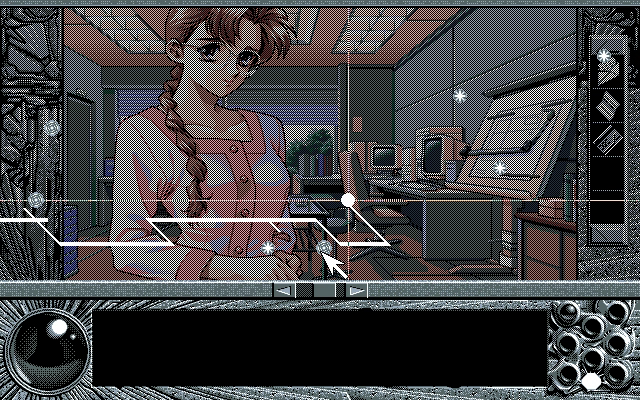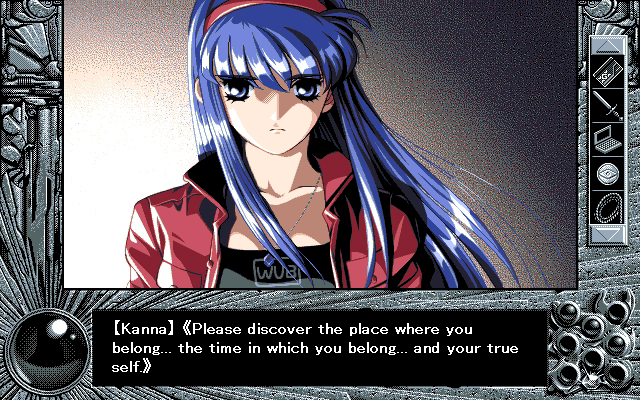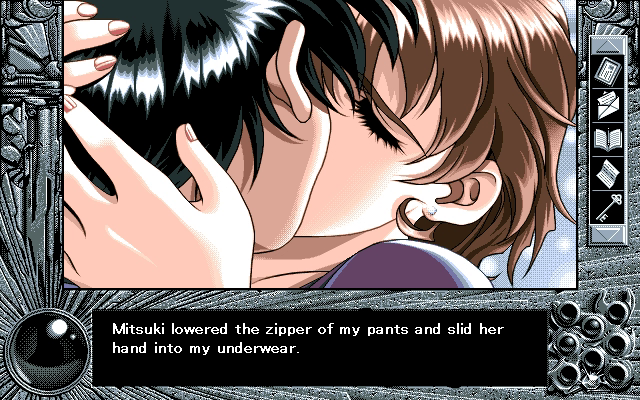Rather than a mystery to be solved, this fundamental piece of worldbuilding proves beneath consideration. YU-NO fails to grapple with Takuya’s powers or their existential implications, instead prioritizing clicking around for hours for irrelevant environmental observations, dirty jokes, repetition of lines about how Takuya is attracted to Ayumi even though she is his mother gosh darn it (let’s say this a hundredth time in case the player missed it), etc. Especially the repetition. Did I mention the script is redundant? Let me explain it this way: the script keeps repeating stuff. Repeating what? The same information. Who is repeating this? Takuya, mostly. Mostly what? I mean Takuya is the one who repeats most of the same information mostly, and is sure to draw it out, too, and add a sex joke. Kanno found nothing he could say with one line he preferred not to say with twenty. In writing the story, he also has horrendously misplaced priorities (aside from being a pedophile).
The ADMS is a more complicated version of the parallel storyline systems Kanno devised for earlier eroge, DESIRE and EVE: Burst Error. These each feature two simultaneous plots starring a different character. DESIRE, for instance, has one storyline in which the player controls Albert and another in which the player controls Makoto, in the same setting at the same time. Controlling one character instead of the other offers the player new perspectives on the gross, distended story (DESIRE also involves pedophilia directed at a blonde twelve-year-old who looks like Yu-no). After YU-NO, Kanno returned to this earlier, simpler model with the “Multitime Zapping System” of the 1998 Exodus Guilty, which features three different related storylines in different time periods.
Compared to these other titles, the ADMS adds more parallel storylines (at least four); narrative branching based on player choice, as opposed to a single route for a given character’s story; and relatively free movement between the distinct routes, instead of cordoning the routes off from each other. The time travel and parallel universe concepts are dressing. Under these clothes, the ADMS is an excuse to hop between different storylines, flashy enough for marketing. This is why Takuya retains no recollection of events between story routes but, when loading a jewel save, instantly regains full memory of what he would have been doing on that timeline: the parallel storylines are not a sincere exploration of the parallel worlds concept but instead different, separate stories happening over the same span of time, as Kanno was already accustomed to writing. The difference is that in YU-NO the stories happen to star who is supposed to be the same character, instead of each having a distinct protagonist. In addition, the developers had a higher budget and were, evidently, hornier (in a gross instead of fun way, sadly).

The ADMS is an intriguing gameplay hook. Its primary function is to ensure the protagonist faces no consequences, ever, no matter what, so that the story barely matters. In a standard time loop story, the character experiencing the time loop learns more and changes over the course of the looping. But in YU-NO, no matter what happens, even Takuya cannot change. Mitsuki’s death means nothing, Yuuki’s death means nothing, Kanna’s death means nothing, Ayumi’s death means nothing—come to think of it, a lot of characters die. None of their deaths matter because the player can and will simply restart the timeline. After a few seconds of drama, Takuya gets over it. While there are not true game overs, these are game overs in effect—in this game over, Ayumi slits her wrists as a cheap way to tug at a player’s heartstrings, and in this one, Yuuki breaks his neck to shock the player into feeling sad for a few seconds as they wonder when Takuya will remember the Reflector.

In most video games, a game over is treated as a mistake in the story. Mario did not die. He survives. The player is the one who screwed up the story, so now they will try to play their role better this time. In YU-NO, however, all these events happen irrevocably in the diagram the characters speak of as Vrinda’s Tree (as though it is a mystical force and not just a complicated tree diagram). These are parallel universes. By reaching good endings, Takuya is not saving any of his friends or lovers. Because he loses his memory, Takuya is not even, in his internal emotional perspective, avenging someone from a different universe. Yuuki or whoever else dies and stays dead. It is some other Yuuki the player might save, having abandoned another world to its tragedy. Similarly, Takuya’s romances are meaningless. The exception is his one true love, his daughter, since he loses the Reflector when he chooses her. Takuya can have sex with every woman yet cheat on none of them and feel authentic love for each one without any emotional complications. Takuya and his lover’s sappy or perhaps tissue-worthy expressions of devotion lend false gravity to what in truth can be only casual flings. For Takuya forgets them, leaving a bereaved girl he will never see again in another universe. In characteristic clueless fashion, Kanno fails to consider the chain of trauma and heartbreak that Takuya leaves in his wake. There is a Reflector, but there is no reflection.
In, for instance, Mega Man, running and shooting is fun for its own sake, not demanding deeper coherence. This action is the core of the video game, the narrative only a context for it. But in a narrative-focused video game like YU-NO, the lack of meaning is a flaw. A sci-fi story that does not engage with its sci-fi concepts fails as a sci-fi story. YU-NO manages vacuity despite the verbosity, its most lauded feature analogously hollow.
